Renewable Energy: Present and Future Problems and Wind Power Analysis
VerifiedAdded on 2023/06/11
|5
|956
|454
Essay
AI Summary
This essay discusses the applications of wind energy, its pros and cons, and the incentives driving its development in the U.S. It explores wind power's role in electricity generation and its technical and environmental viability. The essay also addresses the economic considerations, including turbine costs and the impact on local communities, using Nebraska and Iowa as examples. It concludes by highlighting wind energy's potential for job creation and economic growth, particularly in Iowa, through the development of renewable energy sources and related infrastructure. The essay emphasizes the importance of addressing concerns about environmental impact and ensuring sustainable development in the pursuit of wind energy solutions. Desklib provides access to this and other solved assignments.
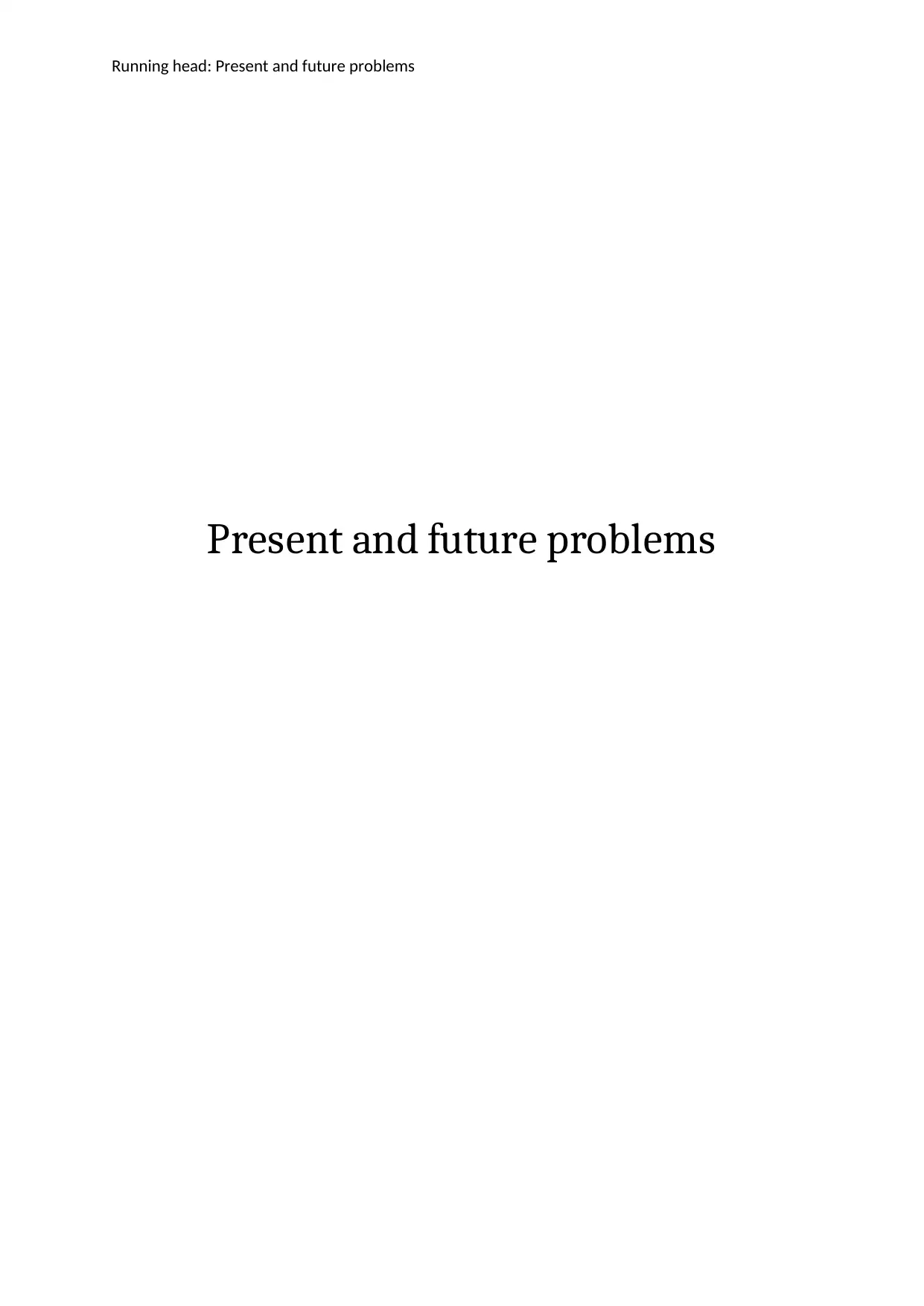
Running head: Present and future problems
Present and future problems
Present and future problems
Paraphrase This Document
Need a fresh take? Get an instant paraphrase of this document with our AI Paraphraser
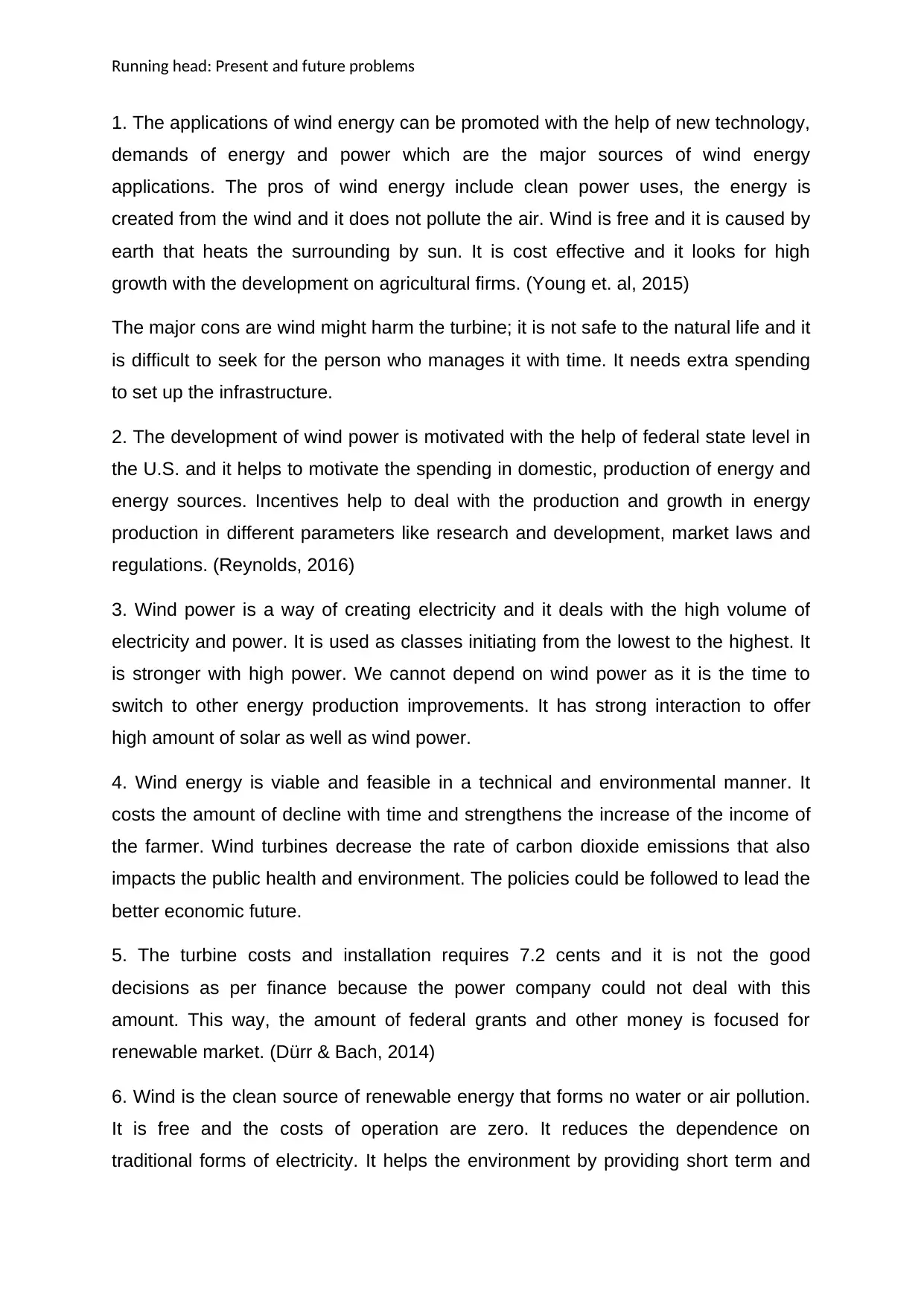
Running head: Present and future problems
1. The applications of wind energy can be promoted with the help of new technology,
demands of energy and power which are the major sources of wind energy
applications. The pros of wind energy include clean power uses, the energy is
created from the wind and it does not pollute the air. Wind is free and it is caused by
earth that heats the surrounding by sun. It is cost effective and it looks for high
growth with the development on agricultural firms. (Young et. al, 2015)
The major cons are wind might harm the turbine; it is not safe to the natural life and it
is difficult to seek for the person who manages it with time. It needs extra spending
to set up the infrastructure.
2. The development of wind power is motivated with the help of federal state level in
the U.S. and it helps to motivate the spending in domestic, production of energy and
energy sources. Incentives help to deal with the production and growth in energy
production in different parameters like research and development, market laws and
regulations. (Reynolds, 2016)
3. Wind power is a way of creating electricity and it deals with the high volume of
electricity and power. It is used as classes initiating from the lowest to the highest. It
is stronger with high power. We cannot depend on wind power as it is the time to
switch to other energy production improvements. It has strong interaction to offer
high amount of solar as well as wind power.
4. Wind energy is viable and feasible in a technical and environmental manner. It
costs the amount of decline with time and strengthens the increase of the income of
the farmer. Wind turbines decrease the rate of carbon dioxide emissions that also
impacts the public health and environment. The policies could be followed to lead the
better economic future.
5. The turbine costs and installation requires 7.2 cents and it is not the good
decisions as per finance because the power company could not deal with this
amount. This way, the amount of federal grants and other money is focused for
renewable market. (Dürr & Bach, 2014)
6. Wind is the clean source of renewable energy that forms no water or air pollution.
It is free and the costs of operation are zero. It reduces the dependence on
traditional forms of electricity. It helps the environment by providing short term and
1. The applications of wind energy can be promoted with the help of new technology,
demands of energy and power which are the major sources of wind energy
applications. The pros of wind energy include clean power uses, the energy is
created from the wind and it does not pollute the air. Wind is free and it is caused by
earth that heats the surrounding by sun. It is cost effective and it looks for high
growth with the development on agricultural firms. (Young et. al, 2015)
The major cons are wind might harm the turbine; it is not safe to the natural life and it
is difficult to seek for the person who manages it with time. It needs extra spending
to set up the infrastructure.
2. The development of wind power is motivated with the help of federal state level in
the U.S. and it helps to motivate the spending in domestic, production of energy and
energy sources. Incentives help to deal with the production and growth in energy
production in different parameters like research and development, market laws and
regulations. (Reynolds, 2016)
3. Wind power is a way of creating electricity and it deals with the high volume of
electricity and power. It is used as classes initiating from the lowest to the highest. It
is stronger with high power. We cannot depend on wind power as it is the time to
switch to other energy production improvements. It has strong interaction to offer
high amount of solar as well as wind power.
4. Wind energy is viable and feasible in a technical and environmental manner. It
costs the amount of decline with time and strengthens the increase of the income of
the farmer. Wind turbines decrease the rate of carbon dioxide emissions that also
impacts the public health and environment. The policies could be followed to lead the
better economic future.
5. The turbine costs and installation requires 7.2 cents and it is not the good
decisions as per finance because the power company could not deal with this
amount. This way, the amount of federal grants and other money is focused for
renewable market. (Dürr & Bach, 2014)
6. Wind is the clean source of renewable energy that forms no water or air pollution.
It is free and the costs of operation are zero. It reduces the dependence on
traditional forms of electricity. It helps the environment by providing short term and
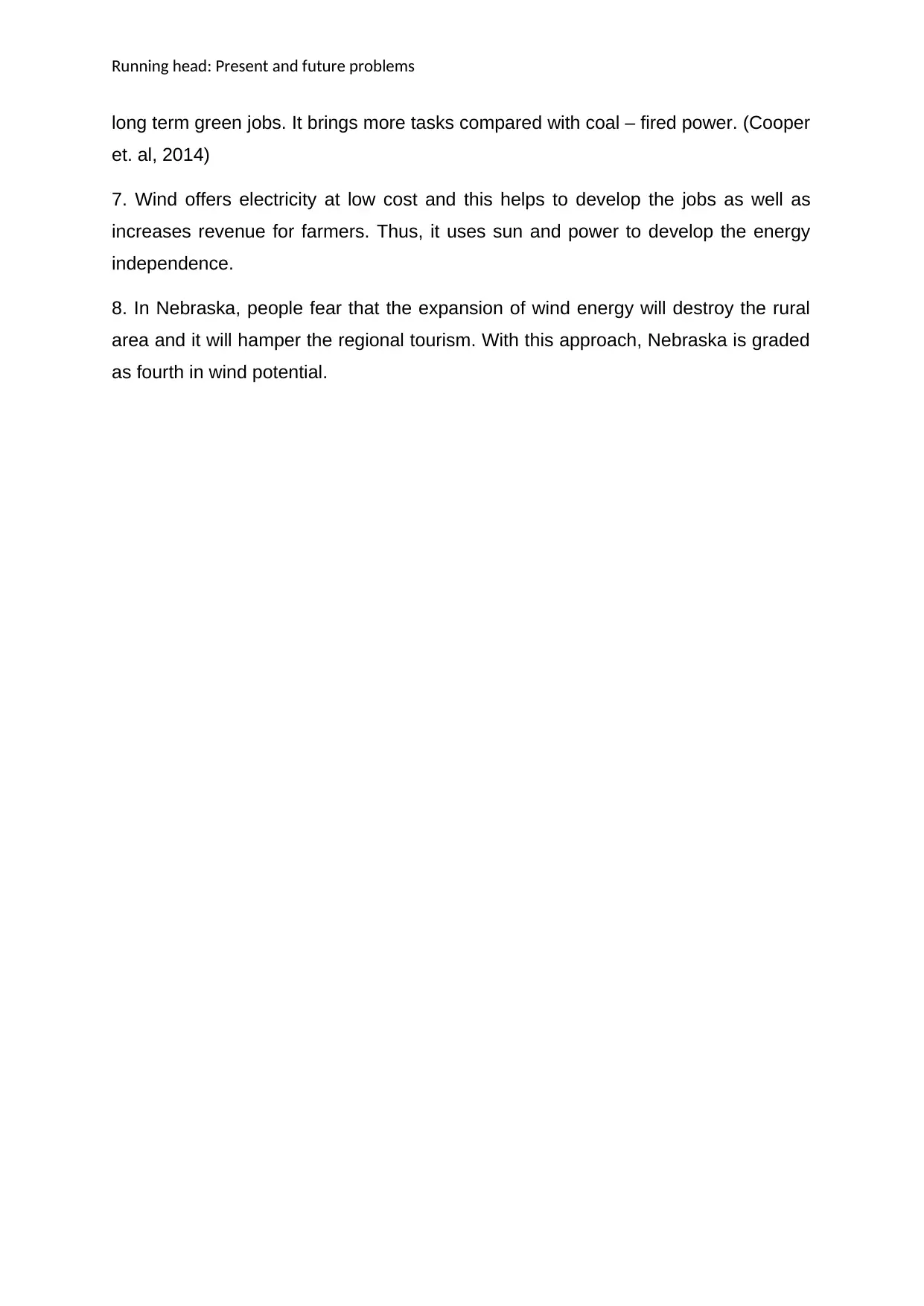
Running head: Present and future problems
long term green jobs. It brings more tasks compared with coal – fired power. (Cooper
et. al, 2014)
7. Wind offers electricity at low cost and this helps to develop the jobs as well as
increases revenue for farmers. Thus, it uses sun and power to develop the energy
independence.
8. In Nebraska, people fear that the expansion of wind energy will destroy the rural
area and it will hamper the regional tourism. With this approach, Nebraska is graded
as fourth in wind potential.
long term green jobs. It brings more tasks compared with coal – fired power. (Cooper
et. al, 2014)
7. Wind offers electricity at low cost and this helps to develop the jobs as well as
increases revenue for farmers. Thus, it uses sun and power to develop the energy
independence.
8. In Nebraska, people fear that the expansion of wind energy will destroy the rural
area and it will hamper the regional tourism. With this approach, Nebraska is graded
as fourth in wind potential.
⊘ This is a preview!⊘
Do you want full access?
Subscribe today to unlock all pages.

Trusted by 1+ million students worldwide
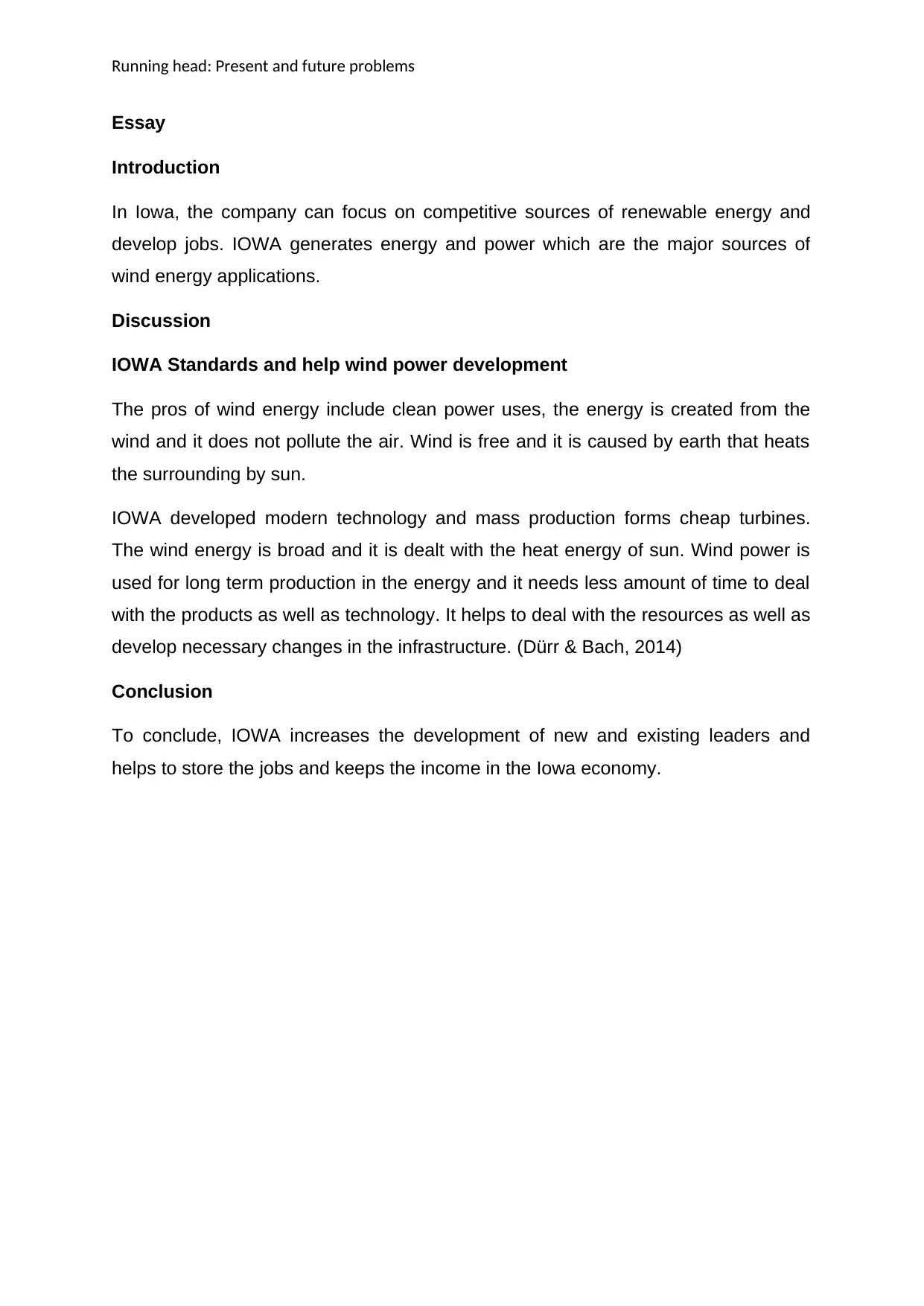
Running head: Present and future problems
Essay
Introduction
In Iowa, the company can focus on competitive sources of renewable energy and
develop jobs. IOWA generates energy and power which are the major sources of
wind energy applications.
Discussion
IOWA Standards and help wind power development
The pros of wind energy include clean power uses, the energy is created from the
wind and it does not pollute the air. Wind is free and it is caused by earth that heats
the surrounding by sun.
IOWA developed modern technology and mass production forms cheap turbines.
The wind energy is broad and it is dealt with the heat energy of sun. Wind power is
used for long term production in the energy and it needs less amount of time to deal
with the products as well as technology. It helps to deal with the resources as well as
develop necessary changes in the infrastructure. (Dürr & Bach, 2014)
Conclusion
To conclude, IOWA increases the development of new and existing leaders and
helps to store the jobs and keeps the income in the Iowa economy.
Essay
Introduction
In Iowa, the company can focus on competitive sources of renewable energy and
develop jobs. IOWA generates energy and power which are the major sources of
wind energy applications.
Discussion
IOWA Standards and help wind power development
The pros of wind energy include clean power uses, the energy is created from the
wind and it does not pollute the air. Wind is free and it is caused by earth that heats
the surrounding by sun.
IOWA developed modern technology and mass production forms cheap turbines.
The wind energy is broad and it is dealt with the heat energy of sun. Wind power is
used for long term production in the energy and it needs less amount of time to deal
with the products as well as technology. It helps to deal with the resources as well as
develop necessary changes in the infrastructure. (Dürr & Bach, 2014)
Conclusion
To conclude, IOWA increases the development of new and existing leaders and
helps to store the jobs and keeps the income in the Iowa economy.
Paraphrase This Document
Need a fresh take? Get an instant paraphrase of this document with our AI Paraphraser
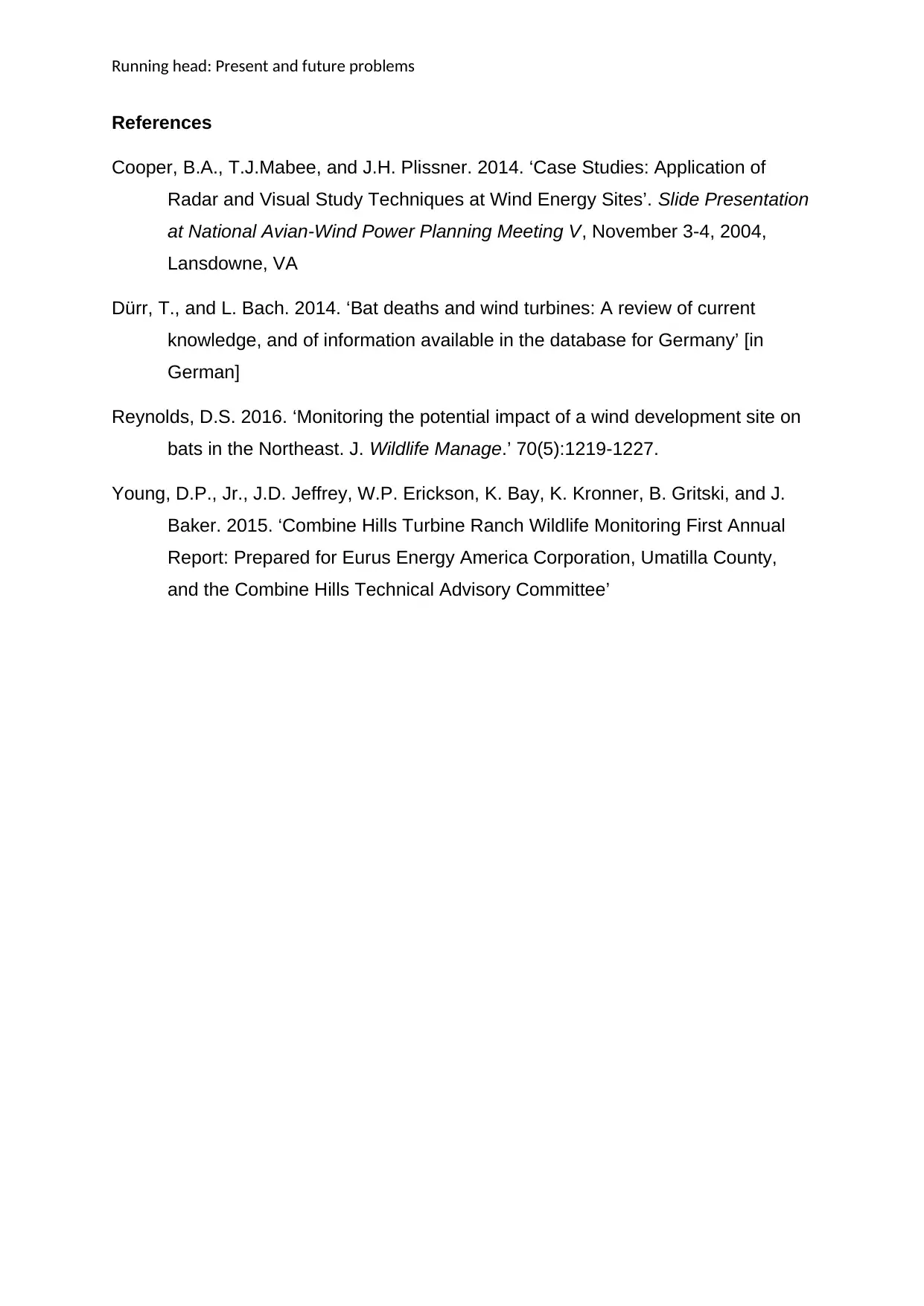
Running head: Present and future problems
References
Cooper, B.A., T.J.Mabee, and J.H. Plissner. 2014. ‘Case Studies: Application of
Radar and Visual Study Techniques at Wind Energy Sites’. Slide Presentation
at National Avian-Wind Power Planning Meeting V, November 3-4, 2004,
Lansdowne, VA
Dürr, T., and L. Bach. 2014. ‘Bat deaths and wind turbines: A review of current
knowledge, and of information available in the database for Germany’ [in
German]
Reynolds, D.S. 2016. ‘Monitoring the potential impact of a wind development site on
bats in the Northeast. J. Wildlife Manage.’ 70(5):1219-1227.
Young, D.P., Jr., J.D. Jeffrey, W.P. Erickson, K. Bay, K. Kronner, B. Gritski, and J.
Baker. 2015. ‘Combine Hills Turbine Ranch Wildlife Monitoring First Annual
Report: Prepared for Eurus Energy America Corporation, Umatilla County,
and the Combine Hills Technical Advisory Committee’
References
Cooper, B.A., T.J.Mabee, and J.H. Plissner. 2014. ‘Case Studies: Application of
Radar and Visual Study Techniques at Wind Energy Sites’. Slide Presentation
at National Avian-Wind Power Planning Meeting V, November 3-4, 2004,
Lansdowne, VA
Dürr, T., and L. Bach. 2014. ‘Bat deaths and wind turbines: A review of current
knowledge, and of information available in the database for Germany’ [in
German]
Reynolds, D.S. 2016. ‘Monitoring the potential impact of a wind development site on
bats in the Northeast. J. Wildlife Manage.’ 70(5):1219-1227.
Young, D.P., Jr., J.D. Jeffrey, W.P. Erickson, K. Bay, K. Kronner, B. Gritski, and J.
Baker. 2015. ‘Combine Hills Turbine Ranch Wildlife Monitoring First Annual
Report: Prepared for Eurus Energy America Corporation, Umatilla County,
and the Combine Hills Technical Advisory Committee’
1 out of 5
Related Documents
Your All-in-One AI-Powered Toolkit for Academic Success.
+13062052269
info@desklib.com
Available 24*7 on WhatsApp / Email
![[object Object]](/_next/static/media/star-bottom.7253800d.svg)
Unlock your academic potential
Copyright © 2020–2025 A2Z Services. All Rights Reserved. Developed and managed by ZUCOL.




